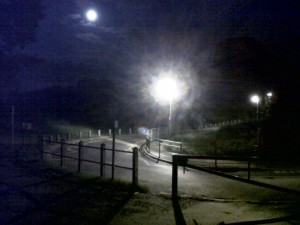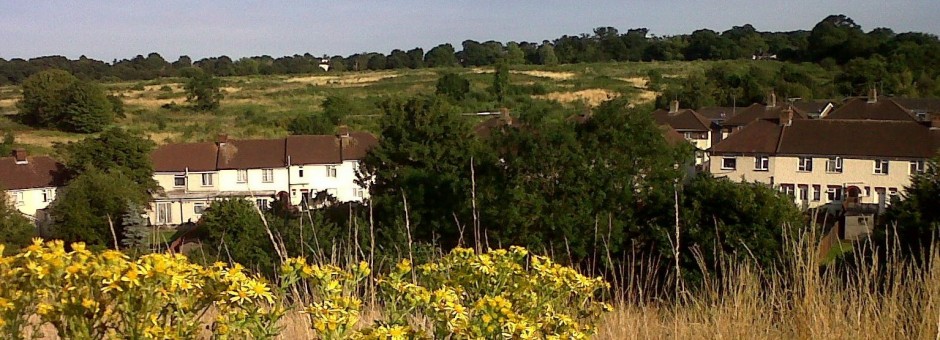Bexley Natural Environment Forum has submitted its concerns over the wildlife impact of the proposed expansion of Bursted school in a consultation that closed today (December 14th). The Forum is concerned about the loss of resources to red-listed bird species in serious decline, that are present in the adjoining Site of Importance for Nature Conservation, and to Bats, that will result from replacing the natural turf playing field with artificial grass. It has suggested that the flat roof design of the new block provides an opportunity for a green or brown roof with frame-mounted solar panels, rather than the bare surface indicated in the illustrative artwork. It has also argued that any major building works should be taken as an opportunity to replace the poorly-directed ‘security’ lighting and stop leaving these and the car park and access roadway lights blazing seven nights a week, causing unnecessary light pollution at taxpayer expense.
The full text of the Forum’s submission follows. A formal planning application will be submitted later, and will provide a further opportunity to comment on or support or oppose aspects of the scheme.
____________
BURSTED SCHOOL EXPANSION COMMENTS, 14th December 2015.
My comments are made on behalf BEXLEY NATURAL ENVIRONMENT FORUM – the umbrella body for Friends of Parks and Open Spaces groups, local wildlife experts and conservationists and sustainability campaigners in the Borough, of which I am Vice-chair. We work to protect, restore and enhance habitats and biodiversity across Bexley.
In an application made in 2014 to erect fencing along the access roadway, the school wrongly claimed that ‘Designated sites, important habitats or other biodiversity features’ and ‘Protected and priority species’ do not occur on, or ‘on land adjacent to or near the proposed development’.
The school was made aware, as a result of comments on that scheme, that Bursted Woods and the adjoining open space is, in fact, a designated Site of Importance for Nature Conservation, and that it does have protected and priority species in it.
We are therefore concerned that it has come forward with a proposal to replace the current grass sports pitch with an artificial surface. The existing grass is providing food in the form of invertebrates and weed seeds for ground-foraging bird species which are likely to include Mistle Thrush, Song Thrush, Redwing, Fieldfare, Starling and House Sparrow, all of which are red-listed due to serious declines in numbers, and have been recorded in and around the woodland itself, including immediately adjacent to the school premises. The field is surrounded by the woodland on two sides, woodland which is home to Bats, all of which are UK, London and Bexley Biodiversity Action Plan species because of concerns about falling populations. ‘Edge habitat’ along tree lines where they grade into more open ground are favourite foraging areas for a number of bat species, including those found in Bursted Woods. The playing field will also be providing a supply of insects with a flying adult stage that provide food for these Bats. The proposal to reduce or deny resources required by these species to make a living is therefore unwelcome, unacceptable and wrong-headed, and we will object to this if it remains in the final plans. We believe that Core Strategy 4.99 which seeks to avoid adverse impacts on SINCS (and by implication the populations of species frequenting them) should be applied.
Some people may think that the proposed loss is small and trivial, but that fails to take into account the sustained onslaught on semi-natural habitat and gardens in London and Bexley, in favour of ‘infrastructure’ and lifeless surfacing of various kinds and the aggregate losses, such that even the Royal Horticultural Society is speaking out in favour of reversing this trend:
http://www.planningresource.co.uk/article/1347519/charity-warns-loss-front-gardens
The RHS study highlights London as the “worst place in the country for paving over front gardens”. It found that half of all front gardens in the capital are paved over – a proportion that has increased by 36 per cent over the past decade.
The RHS said the trend for paving over gardens should be reversed. “Gardens are good for our towns and cities,” said director general Sue Biggs. “This reduction of plants in front gardens is harmful for wildlife, reducing their homes and food sources.”
Replacing natural grass and accessible soil with sterile artificial cover amounts to the same thing. We think it also flies in the face of Core Strategy (LDF) policy CS01(h) which seeks to maintain the best elements of the suburban character of the Borough. Importantly, there is not just a crisis in biodiversity (number of species) but of bioabundance (numbers of individuals of many species), including of previously common species such as House Sparrows and Starlings. This is not down to an act of God, but a constant war of attrition on the habitat they need to make their living through ‘development’ and over-zealous ‘tidiness’.
We would expect educational establishments in the Borough to be acutely aware of these matters and, moreover, to be teaching their pupils about them, not adding to the problem.
The proposal to increase the amount of parking spaces is a negative and backward-looking one, and whilst it is not clear from the indicative artwork, some of it looks like it would result in the loss of mature trees which we would oppose. The school should instead be concentrating on encouraging staff and pupils to walk, cycle or get there by public transport and to look at whether any staff who may live close to one another can give each other lifts.
With regard to the new building block, the location probably means natural light from the side elevations will be at a premium. The artwork suggests a wholly unbroken flat roof. We suggest that skylights or light tubes may help cut artificial lighting requirements, but should be designed so as not to leak light after dark. The flat roof also provides an opportunity to provide a green or brown roof, which could deliver a net increase in the biodiversity value of the site (as long as the grass pitch is not sanitised away) with frame-mounted photovoltaic panels. If roof access was also provided for – with safety railings – then these features could also provide an educational function for the children, as well as positive ‘PR’ for the school.
It is important that any new developments at the school do not increase the intensity of light pollution entering the woodland and surrounding area, do not increase the distance that pollution penetrates and that the amount of light in the blue part of the spectrum is minimised – since this part scatters the furthest and is most biologically disruptive. As we have noted above, Bats occur in the woodland, and recent research has shown that the commer species such as Pipistrelles are negatively affected by light pollution, not just the rarer ones.
Indeed works at the school provide an opportunity to dispense with the existing exterior ‘bulkhead’ lighting and replace it with downwardly-directed lights of low intensity, also bearing in mind the spectrum consideration, preferably motion-activated and not left on all night seven days a week as appears to be the case at present (the bulkhead lights, roadway lights and car park lights were all on at 22.00 on Sunday 13th December). If there is an issue about lighting for emergency services, they are already going to be held up by the extra gate now installed at the foot of the hill, and we would have thought that there could be some automatic linkage installed so that if the gate was opened out of hours and after dark that would trigger the turning on of the lights. The school may have money to burn on wasting electricity and creating light pollution around a SINC, but it’s still doing this with taxpayer’s money despite no longer being under Local Authority control. We note that Bexley Council is trialling a reduction in the period of night-time lighting with a view to rolling this out across the Borough.
We would also ask, bearing in mind the points made above about the decline in previously common species, that the school allows a patch of Bramble and other vegetation to recolonise the bottom part of the roadway, adjacent to the houses on Wenvoe Avenue, so that the gang of House Sparrows that used to use it come back. This was razed by the school in another example an inappropriate ‘tidiness’ mentality negatively impacting declining species. Were car parking to be allowed along part of this verge nearer to the school, such vegetation would reduce the visual impact.

Lights blazing at half past ten at night on the Bursted school access road next to a known Bat site. As part of the expansion plans action should be taken to turn lights off, down and minimise the amount of blue light emitted, which will have environmental as well as cost-saving benefits, believes Bexley Natural Environment Forum. (Photo: Chris Rose)
_______
ENDS
